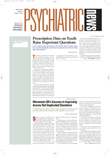Occupancy rates in hospitals providing inpatient care for patients with psychiatric and substance abuse disorders have climbed to historic levels, according to the 2002 Annual Survey Report of the National Association of Psychiatric Health Systems (NAPHS).
In 2001 the average occupancy rate was 74.1 percent, which is a 7.1 percent increase over the 2000 rate. The 2001 occupancy rate is 36 percent higher than the average rate five years ago.
The NAPHS report is based on responses to the association’s annual questionnaire distributed in the summer of 2002. Of the 328 facilities polled, 136 facilities responded, yielding a response rate of 41.5 percent.
NAPHS members include behavioral health care provider organizations, such as specialty hospitals, general hospital psychiatric and addiction treatment units, residential treatment centers, and other providers of care.
Payment is up for the first time in five years, according to the report. Average inpatient net revenue in 2001 increased 9.7 percent to $556 a day.
In a press release announcing the report, NAPHS Executive Director Mark Covall said, “This turnaround is indicative of the growing demand for acute hospital care within all age groups (including children, adolescents, adults, and older adults) and the reduction in capacity as beds have been closed in both the public and private sectors.”
After stabilizing in the past few years, the average length of stay in 2001 declined to 9.3 days, from 10 days in 2000. Overall median lengths of stay declined 4.3 percent to 8.8 days in 2001. Over the past decade, hospital lengths of stay went down 53 percent, from 19.8 days in 1992 to the current 9.3 days.
The percentage of responding institutions offering partial hospitalization and outpatient services has declined. While 82.5 percent (or 99) of survey respondents in 2000 offered partial hospitalization services and 64.2 percent offered outpatient services, in 2001 the percentage of respondents offering partial hospitalization services was only 66.7 percent (or 84), and the percentage offering outpatient services was only 49.2 percent.
It should be noted that some institutions did not respond in both years.
Almost half (48.1 percent) of admissions to respondent hospitals were supported by state or federal programs. Patients supported through Medicaid or Medicare programs accounted for 42.1 percent of all inpatient admissions in 2001.
The report is available for $400 from NAPHS at 325 Seventh Street, N.W., Washington, D.C. 20004-2802.
